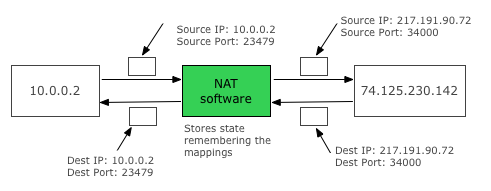Network Address Translation
I’ve often heard people talking about Network Address Translation (NAT) but I never really understood exactly how it worked until we started configuring some virtual data centres on my current project.
This is an attempt at documenting my own current understanding so I won’t forget in future.
In our case we’ve been provisioning a bunch of machines into different private networks, and each machine therefore has an IP in the range of IPv4 addresses reserved for private networks:
-
10.0.0.0 - 10.255.255.255
-
172.16.0.0 - 172.31.255.255
-
192.168.0.0 - 192.168.255.255
We’ve been using IP addresses from the 10...* allocation so all our machines have an IP address in that range.
As I understand it private IP addresses were initially allocated because there are a limited number of IPv4 addresses available and because we don’t necessarily want every machine to be directly accessible to the internet.
NAT becomes necessary when we want machines outside the private network to access our machine (e.g. we want to host a web server) or if we want to access things outside the network from our machine (e.g. we want to run an 'apt-get update').
In the first case we’d already have a publicly accessible IP address but creating a connection to it would only take us to a router/firewall.
If we want the connection to make its way to our web server we’d need to create a Destination NAT (DNAT) rule which will translate the destination IP address and port in the IP header of the IP packet accordingly.

We’ve created a little DSL which allows us to define these rules:
dnat :original => { :ip => "217.191.90.72", :port => 80 },
:translated => { :ip => "10.0.0.2", :port => 80 }As far as I understand it there would be a table which keeps track of these rules and if it sees request coming in on 217.191.90.72 on port 80 it will forward that on to 10.0.0.2 port 80.
If it’s for any other port then there will will be no such forwarding.
If we want to access the internet from our 10.0.0.2 machine we will need to put in a Source NAT (SNAT) rule to translate our source IP address and port otherwise any machines we send a request to will have no way of routing the response back to us.
In this case we wrote a more encompassing rule since we want all the machines in any of our networks to be treated the same way:
snat :original => { :ip => "10.0.0.0/8" }, # this means 10.*.*.*
:translated => { :ip => "217.191.90.72" }In this example 217.191.90.72 would be a public IP address that we have available and any requests coming from machines within our network will look like they came from there.
If we make a request to google (74.125.230.142) from 10.0.0.2 we might create a TCP connection using port 23479 so our NAT software would at least need to translate the source IP from 10.0.0.2 to 217.191.90.72 and possibly the port too.
The NAT software creates some sort of internal state in a NAT session to remember the translations that have been done so that when the response comes back from google it can be routed back to 10.0.0.2 on port 23479.

There is more going on behind the scenes to ensure that the checksums are changed accordingly but conceptually this is what’s happening.
The TCP/IP red book has a section where it explains this in more detail but I found the chapter in TCP/IP Illustrated: The Protocols an easier read.
If I’ve got anything wrong please feel free to point it out in the comments and I’ll update the post.
About the author
I'm currently working on short form content at ClickHouse. I publish short 5 minute videos showing how to solve data problems on YouTube @LearnDataWithMark. I previously worked on graph analytics at Neo4j, where I also co-authored the O'Reilly Graph Algorithms Book with Amy Hodler.
